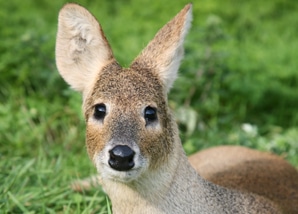24-Hour Emergency Helpline 01844 292292

Home / Animal Factsheets / Mice
Mice
Quick Links
Handling Tips
General Information
Relatives
Conservation Status
Traits
Identification
Habitat
Young
Feeding Habits
Casualties
There are three species of native mice (not counting the House Mouse, which is an introduced species).
| Name | Latin Name |
| Wood Mouse | Apodemus sylvaticus(Also known as field mouse) |
| Harvest Mouse | Micromys minutus |
| Yellow-necked Mouse | Apodemus flavicollis |
Handling Tips
Mice should be handled using closed cupped hands and placed in a breathable container with a secure lid. Be careful, they can bite.
General Information
A mouse is a small mammal which is primarily nocturnal. The best known mouse species is the common house mouse. However, in some places certain kinds of field mice are also common. There are over 30 known species in total.
Relatives
Mice are found in vast numbers on all continents, other than Antarctica. They belong to the order of Rodents which also include rats, squirrels, porcupines, beavers, guinea pigs and hamsters.
Conservation Status
All are listed as Least Concern. However, the Harvest Mouse is listed as priority species on the UK Biodiversity Action Plan.
Although there are no threats listed for mice they are a staple in the diet of many small carnivores “Meat Eaters”.
Traits
Mice compensate for their poor eyesight with a keen sense of hearing, and rely especially on their sense of smell to locate food and avoid predators. Characteristically Mice have a pointed snout, small rounded ears, and a long naked or almost hairless tail. They use their sharp incisors to knaw wood, break into food, and bite predators.
Identification
The Wood Mouse It is closely related to the Yellow Necked Mouse but differs in that it has no band of yellow fur around the neck, it has slightly smaller ears, and is usually slightly smaller overall: around 90 mm (3.54″) in length.
The Harvest Mouse has a blunt muzzle and small hairy ears. The tip of the tail is prehensile (capable of gripping) and is used to assist climbing. The fur is yellow/brown, with a white underside. Head and body length: 5-8cm, Weight: 5-11g.
Yellow-necked mice are similar in appearance to wood mice, who they are closely related to. They can be distinguished by a yellow spot that extends sideways to form a collar. They are also slightly larger than wood mice. Head and body length: 10-12cm, Weight: 25-45g.
Habitat
A mouse has remarkable adaptability to almost any environment and is one of the most successful mammals living on Earth today. They build intricate burrows in the wild. These burrows typically have long entrances and are equipped with escape tunnels and routes, although they are naturally ground dwellers, some species are also agile climbers and leapers as well as capable swimmers.
Wood Mice inhabit forests, grasslands, and cultivated fields. Almost entirely nocturnal and terrestrial, wood mice burrow extensively, build nests of plants and live in buildings during harsh seasons. Harvest Mice inhabit hedgerows and reed beds, and other areas of tall, dense vegetation. Yellow Necked Mice favour deciduous woodland, but they are also found in orchards and gardens, and often enter houses.
Young
The young are called pups and they weigh 0.5 – 1.5g at birth. They are born hairless and have closed eyelids and ears. The Wood Mouse has a breeding season from February to October in which multiple matings occur between males and females. The gestation period of wood mice is of 25–26 days and each female produces on average five young. The offspring become independent after about three weeks and become sexually active after two months.
After a gestation period of 17-19 days, the female Harvest Mouse gives birth to 1-7 young. They produce up to three litters a year. The breeding season ranges from May to October. The female abandons the young after 15-16 days, but the young may still use the nest for a further few days.
The breeding season for Yellow Necked Mice runs from February to October, during which females give birth to 4-7 young after a gestation period of 23 days. The young are weaned after three weeks. Their distinctive yellow collars become visible after two weeks, at about the same times as they first open their eyes.
Feeding Habits
Mice are largely herbivores, consuming any kind of fruit or grain from plants. However, mice adapt well to urban areas and are known for eating almost all types of food scraps. Their food intake is approximately 15 g per 100 g of body weight per day; water intake is approximately 15 ml (0.53 fl oz) per 100 g of body weight per day.
Casualties
If you’ve found a sick/injured/orphaned wild animal please see our Emergency section for help or call 01844 292292.
The most common injuries we see in both adults and babies are puncture wounds caused by cats. We also see litters of babies which have been dug up when people have cleared their sheds or outbuildings. Very young mice require hand rearing and very specialist care.
Make a donation
By donating to Tiggywinkles, you will be helping us provide life-saving treatment and care to all species of British Wildlife.




